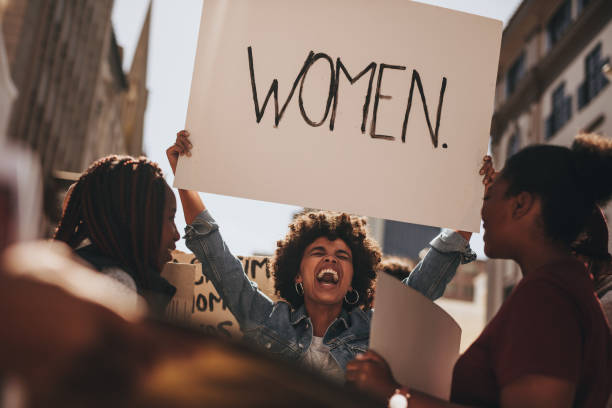What is Intersectional Feminism?

If you’re new to the term “intersectional feminism,” it might be hard to understand what it is and how it relates to your personal beliefs. In this article, we’ll explore what intersectional feminism is, how it works, and some of the key benefits that come with being a part of this movement. So whether you’re new to the term or already familiar with its concepts, read on for a crash course in intersectional feminism!
What is Intersectional Feminism?
Intersectional feminism is a term used to describe a feminism that takes into account the ways in which different forms of oppression intersect with each other. This means that intersectional feminists are not only focused on the issues of gender, race and sexuality, but also concern themselves with class, disability, and other axes of inequality.
One of the most important goals of intersectional feminism is to help dismantle the structures that perpetuate discrimination and injustice. This includes everything from patriarchy to systemic racism and economic inequality. In order to do this, intersectional feminists believe that it is important to understand how these various forms of oppression work together.
Intersectional feminism has become increasingly important in recent years due to the rise of various forms of discrimination. For example, transgender people experience high levels of discrimination both in the workplace and in everyday life. Similarly, people with disabilities often encounter discrimination in both their personal lives and in society at large.
Although there are still many challenges facing intersectional feminists, their work is essential if we want to create a more equitable society.
What are the Principles of Intersectional Feminism?
Intersectional feminism is a movement that recognizes the interconnectedness of different forms of discrimination and oppression, and works to address them collectively. The principles of intersectional feminism are:
- All forms of discrimination and oppression are connected.
- Oppression is hierarchical. It is inflicted from the top down, and it is associated with power, privilege, and status quo advantages.
- Oppression is based on intersecting systems of identity (e.g., race, gender, sexuality, class).
- oppressors benefit from oppressed people’s oppression in various ways (e.g., through access to resources, social support, or reduced resistance).
- Oppressed groups share common vulnerabilities and experiences that make them more vulnerable to exploitation and abuse.
- Intersectional movements work together to build power for all oppressed groups by sharing information and strategies, organizing campaigns and events, and working collaboratively with allies across movements.
You may also like;
- When did Apartheid end?
- How did Catherine the Great die?
- How long did the attack on pearl harbor last?
Frequently Asked Questions about what Intersectional Feminism means
How Does Intersectional Feminism Affect Women’s Lives?
Intersectional feminism is a movement that focuses on the intersectionality of various oppressions faced by women. It aims to expose the interconnectedness of gender, race, class, sexuality, ability, and other forms of oppression. This can have a profound impact on the lives of women, as it allows them to see themselves as part of a larger group with shared experiences and concerns.
One of the main benefits of intersectional feminism is that it challenges traditional ideas about what it means to be a woman. For example, many people believe that being a woman requires being gentle and passive, which is not always true for women who experience discrimination or violence based on their gender. Intersectional feminism allows these women to get recognition and support for their unique experiences and perspectives.
Another benefit of intersectional feminism is that it helps women identify and challenge injustices in their own lives. For example, if a woman experiences abuse from her partner but is also from a marginalized community (such as Native American or LGBTQ), she may be more likely to suffer from chronic trauma. Intersectional feminism can help her understand her experience in terms of the broader context of her oppression.
What is an example of intersectional feminism?
One example of intersectional feminism could be when a person believes that race and gender are both important factors in how people experience discrimination and inequality. This means that an intersectional feminist would also focus on issues like sexism, racism, homophobia, transphobia, ableism, and classism.
What is the main idea of intersectionality?
Intersectionality refers to the idea that different forms of discrimination and oppression against women intersect with each other and that one’s sex, race, class, and sexual orientation all play a role in how those intersecting oppressions impact one’s experience. The term was coined in the late 1980s by black feminists Kimberlé Crenshaw and Gloria Anzaldúa, though it has been used in various ways by various feminists since then.
One example of how intersectionality can influence feminist analysis is when looking at violence against women as an intersectional issue. If a woman is also marginalized based on her race or ethnicity, for instance, she may be more likely to experience physical abuse at the hands of her partner than a woman who is not marginalized based on those factors. In addition, experiencing multiple forms of oppression can make it harder for women to escape abusive relationships – they may not have access to safe housing or legal resources because they are also facing discrimination based on their sex or class, for example.
In general, intersectionality advocates for a more holistic understanding of the ways in which sexism and other forms of discrimination impact women’s lives.
What is female intersectionality?
Intersectional feminism is a term used to describe the way in which people of different genders, races, and sexual orientations experience discrimination and oppression. In other words, intersectionality theory says that everyone is affected by multiple forms of discrimination and oppression, not just one group of people.
Female intersectionality is a term used to describe the way in which women experience discrimination and oppression. This includes things like sexism and misogyny, as well asrace, class, ethnicity, sexual orientation, ability, and age discrimination.
There are a lot of different ways that female intersectionality can be experienced. Some women may experience more than one type of discrimination or oppression at the same time. Others may only experience one type of discrimination or oppression but feel that it impacts their overall life experiences in a negative way.
There is no one right way to understand or experience female intersectionality. What matters most is that everyone has a voice and gets the opportunity to share their experiences with others.
Conclusion
Intersectional feminism is a term used to describe the intersectional experiences of women. It encompasses not only the experience of being a woman, but also intersects with race, class, sexuality, ability status and other social identities. As such, it provides an understanding of the ways in which oppression and discrimination affects all women and recognizes that these oppressions are interconnected. Through promoting intersectional feminism, we can work together to create a society that is more equitable for all women.
For more general updates, visit dailygam.
Last Updated 3 years by










